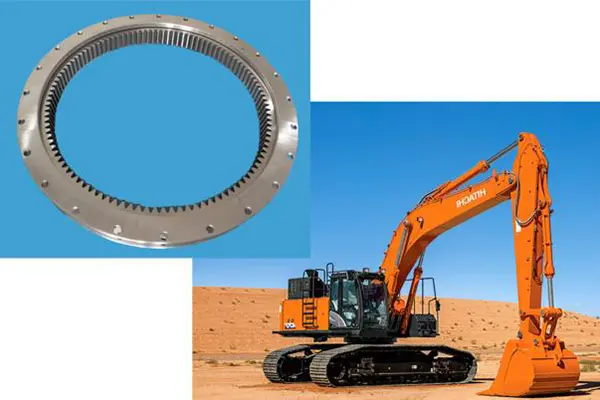
What is an Excavator Slewing Bearing?
2024-08-27
An excavator slewing bearing, also known as a slewing ring or turntable bearing, is a critical component in excavators and other heavy machinery. It plays a vital role in the functionality and efficiency of the equipment, enabling smooth rotation of the upper structure, or “house,” of the excavator relative to the undercarriage or base. This rotation is essential for tasks such as digging, lifting, and loading, allowing the operator to maneuver the excavator’s arm and bucket in various directions without needing to reposition the entire machine.

Understanding the Slewing Bearing: Structure and Function
At its core, a slewing bearing is a large, mechanical ring that consists of an inner ring, an outer ring, and rolling elements such as balls or rollers. These components work together to support axial, radial, and moment loads simultaneously.
- Inner and Outer Rings: The inner ring is typically attached to the excavator’s upper structure, while the outer ring is fixed to the undercarriage. These rings are made of high-strength steel to withstand the significant forces exerted during operation.
- Rolling Elements: The rolling elements, which can be balls or cylindrical rollers, are housed in a raceway formed by the inner and outer rings. These elements reduce friction and allow for smooth rotation between the two rings.
- Seals and Lubrication: Slewing bearings are equipped with seals to protect the internal components from contamination by dirt, dust, and moisture. Proper lubrication is also essential for the longevity and efficiency of the bearing, reducing wear and preventing corrosion.
Types of Slewing Bearings for Excavators
Slewing bearings come in various types, each designed to handle different loads and operating conditions. The choice of bearing depends on the specific requirements of the excavator and its intended use. The most common types of slewing bearings used in excavators include:
- Single-row Ball Bearings: These bearings consist of a single row of balls between the inner and outer rings. They are suitable for applications with lower radial and axial loads and are typically used in smaller excavators.
- Double-row Ball Bearings: Featuring two rows of balls, these bearings can handle higher loads and provide greater stability. They are often used in medium to large excavators that require robust performance.
- Single-row Cross Roller Bearings: These bearings have cylindrical rollers arranged in a crisscross pattern, allowing them to handle higher axial loads and tilting moments. They are ideal for heavy-duty excavators that perform demanding tasks such as lifting and digging in challenging terrains.
- Double-row Roller Bearings: With two rows of rollers, these bearings can manage very high loads and are used in the largest excavators, where durability and load capacity are paramount.
Importance of Slewing Bearings in Excavators
The slewing bearing is a pivotal part of an excavator’s operational efficiency and safety. Here are some reasons why slewing bearings are so important:
- Smooth and Controlled Movement: Slewing bearings allow for the smooth rotation of the excavator’s upper structure, enabling precise control of the arm and bucket. This control is essential for performing tasks accurately, whether digging trenches, loading trucks, or lifting heavy materials.
- Load Management: Excavators often handle heavy loads and work in challenging environments. Slewing bearings are designed to manage these loads effectively, ensuring that the equipment operates safely and reliably. They distribute forces evenly across the bearing, preventing undue stress on any single component.
- Durability and Longevity: High-quality slewing bearings are built to last, with robust materials and design features that withstand harsh conditions and heavy use. This durability reduces maintenance needs and minimizes downtime, which is crucial for maximizing productivity on construction sites.
Maintenance and Care of Excavator Slewing Bearings
Proper maintenance is essential to ensure the longevity and performance of an excavator’s slewing bearing. Here are some key maintenance practices:
- Regular Inspection: Routine checks for signs of wear, such as unusual noises, vibrations, or excessive play, can help identify potential issues before they lead to failure. Inspecting the seals for damage and checking for leaks is also important to maintain the integrity of the bearing.
- Lubrication: Keeping the bearing properly lubricated is vital for reducing friction and preventing wear. Operators should follow the manufacturer’s recommendations for lubrication intervals and use the specified type of grease.
- Cleaning and Protection: Keeping the bearing clean and free from contaminants is crucial. Dirt and debris can accelerate wear and cause damage to the rolling elements and raceways. Protective covers can be used to shield the bearing from harsh environmental conditions.
- Load Monitoring: Avoiding overloading the excavator beyond its designed capacity can significantly extend the life of the slewing bearing. Operators should be aware of the machine’s limits and avoid using it for tasks that exceed these limits.
Conclusion
The excavator slewing bearing is an indispensable component that enables the efficient and safe operation of excavators. By facilitating smooth rotation and handling significant loads, slewing bearings ensure that these powerful machines can perform a wide range of tasks in construction, mining, and other industries. Understanding the different types of slewing bearings and the importance of proper maintenance can help operators and maintenance teams ensure the reliability and longevity of their equipment, ultimately contributing to the success of their projects.





